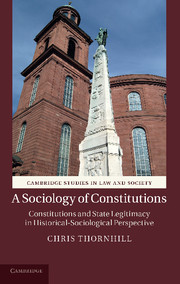 A Sociology of Constitutions
A Sociology of Constitutions Published online by Cambridge University Press: 07 September 2011
Constitutions after 1848
As discussed, the revolutionary constitutions of the later eighteenth century did much to consolidate the power of central states, and in supplying the idea that the nation of rights holders was the origin of legitimate state power they greatly simplified the social abstraction and circulation of political power. The constitutions of 1848, then, consolidated the state as a broad-based body of institutions, and they at once heightened the power of states and distributed power in more even fashion through society by enunciating the principle that all members of a national society had a common and equal relation to political power. In both periods, the forming of constitutions continued a process of political distillation that had shaped most European states throughout the seventeenth and eighteenth centuries, and the patterns of liberal-national constitutional formation that culminated in the middle of the nineteenth century extended the centralistic and inclusionary impetus of earlier constitution writing. Indeed, as discussed, the liberal-national constitutional movement resulted directly from the primary state-building tendencies of the age of ‘absolutism’. Naturally, this does not imply that the constitutional models that emerged in the age of revolution did not profoundly alter the inner organization of states, and that their emphasis on popular sovereignty and rights-based self-legislation did not produce a condition of more equal legal and political inclusivity in society in which a popular legislature played an increased role in governance. However, the revolutionary constitutions of the period 1789–1848 formed a structural continuum with the administrative innovations typical of ‘absolutism’.
To save this book to your Kindle, first ensure [email protected] is added to your Approved Personal Document E-mail List under your Personal Document Settings on the Manage Your Content and Devices page of your Amazon account. Then enter the ‘name’ part of your Kindle email address below. Find out more about saving to your Kindle.
Note you can select to save to either the @free.kindle.com or @kindle.com variations. ‘@free.kindle.com’ emails are free but can only be saved to your device when it is connected to wi-fi. ‘@kindle.com’ emails can be delivered even when you are not connected to wi-fi, but note that service fees apply.
Find out more about the Kindle Personal Document Service.
To save content items to your account, please confirm that you agree to abide by our usage policies. If this is the first time you use this feature, you will be asked to authorise Cambridge Core to connect with your account. Find out more about saving content to Dropbox.
To save content items to your account, please confirm that you agree to abide by our usage policies. If this is the first time you use this feature, you will be asked to authorise Cambridge Core to connect with your account. Find out more about saving content to Google Drive.